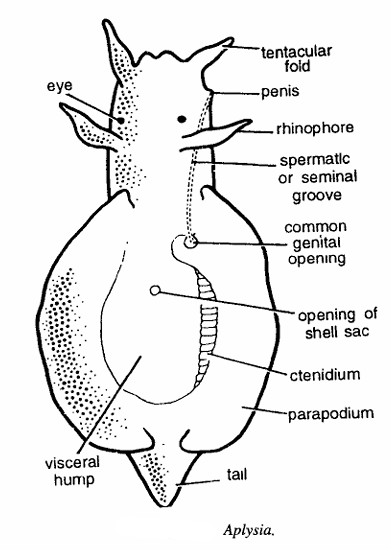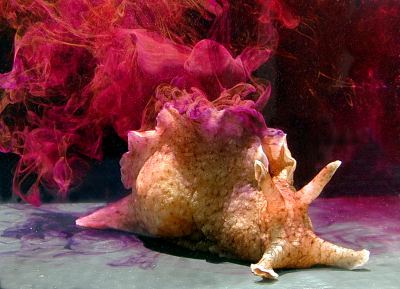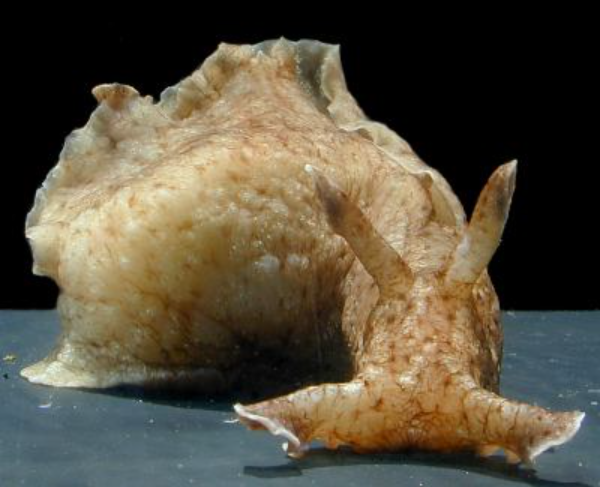Aplysia: Morphology, Classification, Habitat, and Neurobiological Importance of the Sea Hare
Aplysia is a genus of large sea slugs commonly known as sea hares, belonging to the family Aplysiidae. These marine gastropod mollusks are notable for their soft, often leathery bodies and reduced internal shells. Sea hares have distinctive parapodia—wing-like flaps—that aid in swimming, and their two pairs of tentacles give the head a rabbit-ear appearance, inspiring their common name. Found primarily in shallow waters of tropical and temperate oceans, Aplysia species graze on algae and seaweed, playing vital roles in coastal ecosystems. The genus has gained wider scientific attention for its utility as a neurobiological model organism, especially in studies on learning and memory.
Classification of Aplysia
| Taxonomic Rank | Name | Characteristics |
|---|---|---|
| Kingdom | Animalia | Multicellular eukaryotic organisms |
| Phylum | Mollusca | Soft-bodied animals with muscular foot and mantle |
| Class | Gastropoda | Snails and slugs with reduced or absent shells |
| Order | Anaspidea | Sea hares with paired parapodia and two pairs of tentacles |
| Family | Aplysiidae | Large sea slugs with ink glands and internal reduced shells |
| Genus | Aplysia | Sea hares with soft bodies, parapodia, and chemical defenses |

Habit and Habitat
Aplysia species inhabit shallow coastal waters, tide pools, seagrass beds, and coral reefs, with distributions primarily in tropical and temperate marine regions worldwide. They are benthic herbivores, feeding mainly on red and green algae. Their coloration and body texture often reflect the pigments from their algal diet, providing camouflage against predators.
Aplysia moves slowly along the substrate using its large muscular foot and can swim short distances by flapping its parapodia. When threatened, many species eject ink clouds containing deterrent chemicals to evade predators.
Geographical Distribution
Aplysia species are found globally, with significant diversity in the Indo-Pacific region. Notable species such as Aplysia californica inhabit the eastern Pacific coasts of North America, while others like Aplysia dactylomela occur in Caribbean and Atlantic waters. Their range includes various shallow marine ecosystems conducive to macroalgal growth.
General Characteristics
- Commonly called as sea hare.
- Body of the animal is soft, slimy, fleshy and whitish or greenish in colour.
- Anterior end bears head and neck. Animal is slug-like, with the anterior angles of the head extended into two large tentacular folds.
- Besides anterior tentacular fords, there are pair of eyes and behind eyes another tentacular fold like structure called as rhinophores.
- Mantle cavity is open on the right side with backwardly pointing ctenidium through a longitudinal slit.
- Anus is posteriorly located. Opening of shell sac and seminal groove is also seen.
- Foot is muscular, and elongated pointed posteriorly.
- On the lateral side, there is a pair of large fleshy outgrowths called as parapodia, which project upwards and inwards to enclose visceral hump and are used as fins for swimming.
- Shell is internal and rudimentary. Opening of shell sac and spermatic seminal groove also seen. Animal is bisexual with a single gonoduct and a common genital opening.
- Body: Soft, often large and elongated, with parapodia covering much of the dorsum.
- Size: Species vary widely; some can grow over 40 cm in length.
- Tentacles: Two pairs; a larger set on the head resembling rabbit ears (rhinophores) and a smaller oral pair near the mouth.
- Shell: Internal, reduced, and thin; not externally visible.
- Coloration: Varied; frequently mottled or camouflaged with algae coloring.
- Ink Glands: Produce purple or reddish ink as a defense mechanism.
- Sensory Organs: Eyes with limited vision; primary reliance on chemical and tactile sensing.

Special Features
- Chemical Defense: Ejection of ink containing deterrents to confuse or repel predators.
- Neurobiology: Model organism for studying learning and memory due to its simple nervous system and large neurons.
- Reproductive Behavior: Hermaphroditic, capable of reciprocal mating; often form mating chains.
- Locomotion: Slow crawling complemented by capability to swim short distances through parapodial flapping.
- Feeding Adaptations: Specialized radula scrapes algal surfaces efficiently.
- Life Cycle: Includes trochophore and veliger larval stages before settling to benthic adulthood.
Identification
Identification relies on:
- Body size, shape, and coloration patterns.
- Presence and morphology of parapodia and tentacles.
- Internal shell characteristics in dissected specimens.
- Geographic and ecologic range.
- Molecular markers used to delineate species.
Life Cycle and Reproduction
Aplysia are simultaneous hermaphrodites and often mate promiscuously, using chemical cues to find partners. Mating can involve multiple individuals forming a ‘daisy chain’ with reciprocal sperm transfer. Egg masses are laid in gelatinous strings, commonly pink or orange, often containing thousands to millions of embryos.
Larvae are planktonic trochophore and veliger stages before metamorphosing into juveniles. Growth to sexual maturity varies but may occur within months under optimal conditions.

Ecological Role and Importance
- Herbivory: Control algal growth on coastal substrates.
- Prey: Food source for fish, crabs, and other predators.
- Scientific Research: Key model in neuroscience for synaptic plasticity and behavior studies.
- Environmental Indicator: Sensitive to habitat changes, pollution, and algal availability.
- Cultural Importance: Occasionally used in local seafood traditions.
References
- https://en.wikipedia.org/wiki/Aplysia
- https://animaldiversity.org/accounts/Aplysia_californica/
- https://aplysia.rsmas.miami.edu/biology-of-aplysia/biological-description/index.html
- http://www.seaslugforum.net/showall/aplydact
- https://en.wikipedia.org/wiki/Aplysia_fasciata
- https://pmc.ncbi.nlm.nih.gov/articles/PMC4024469/
- https://www.sciencedirect.com/topics/biochemistry-genetics-and-molecular-biology/aplysia
- https://www.britannica.com/animal/Aplysia
- https://marinesanctuary.org/blog/sea-wonder-sea-hare/
- https://aggrc.com/aplysia.php
